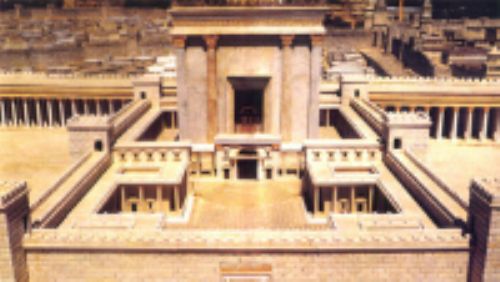Archaeological findings and reconstructions from the ruins of Jerusalem at the time of Jesus and the Apostles is fascinating in its own right. To be able to visualize millennia-old structures provides a connection to the past, and for the Christian, vividly illustrates how God's Word endured the ages far better than man's work. Our faith does not rest on old, weathered stones but on the solid Rock. The gate called Beautiful (Acts 3:2,10) exemplifies this, as scholars don't agree on just what this is!
First, let's review the Biblical data on this gate. The lame man healed by Peter was at here daily as people passed through to go into the temple at the hour of prayer (v.1), a daily event. After his healing, he walks and leaps with them into the temple, holding on to Peter and John (v.8), and is soon joined by a crowd in the porch that is called Solomon's, a large flat area just inside the wall. While this porch bears that name today, there are no other references to this gate other than what we read in Acts 3, nor are any gates in the old city today called by that name. Thus, from what can be surmised, the term Beautiful is the gate's colloquial title, reflecting its beauty. So, all we need to do is identify a beautiful temple gate, right?
The first century Jewish historian Josephus notes the nine gates and posts were completely overlaid with gold and silver, but one outside the sanctuary was of costly Corinthian bronze. It shown magnificently in the sun. Funded by private citizen Nicanor, it was big and truly stood out. Just inside these single-leafed gates surrounding the inner temple was Solomon's porch, where 13 treasure chests were placed for the tithe, sin, and voluntary offerings. Surely this is the gate of our beggar! In addition to Josephus, other historians such as Thackeray, Edersheim and Lightfoot agree. The diagram [1] to the right shows its relative size and location, as well as a problem which other scholars point out with this selection. How would the blind man enter this gate with the disciples to get back to Solomon's porch? Temple court rules restricted people with physical issues of blood from getting close to the holy inner temple, potentially restricting his passage, so how would he even get that far to begin with?

Others observe that the word horaios, translated beautiful, doesn't normally mean beautiful. They suggest the word relates to "golden", meaning a golden gate. The eastern Sushan gate was both beautiful and golden. But what's beautiful about a gate so visibly inferior to Nicanor? These scholars point out the Sushan gate is named for an elaborate sculpted relief of the city of Susa and its palace (think of Queen Esther). When healed, he could easily enter in, climbing a few steps up to Solomon's porch. Detractors point out this inferior gate was mainly used for ceremonial purposes and faced east, not south where nearly all of the city's inhabitants lay; thus, it wouldn't have much traffic. Archeological purists, not holding the Word as divinely inspired, suggest one of two south gates, double leafed, with ornately sculpted roofs along its entrance, and where most of public traffic came.
One solution for the Nicanor gate is to distinguish between the inner temple and the outer temple. John Lightfoot [2] points out the Nicanor gate led both into the inner temple as well as back to the outer temple; either way led into the temple. This makes it a preferred choice. Spiritually speaking, there is only one gate to God's holiest heaven, the strait gate, while many are the gates of death; and it is this gate of the Lord into which the righteous shall enter. Thus, spiritual healing occurs outside only one gate. His physical recovery there typifies salvation magnificently, since he returns to the area of many gates, to do as King David the sweet Psalmist was inspired to write, that I may shew forth all thy praise in the gates of the daughter of Zion: I will rejoice in thy salvation.
[1] Drawing: Leen Ritmeyer, archaeological architect who labored 30 years on modelling the temple; https://www.ritmeyer.com/2010/12/14/the-beautiful-gate-of-the-temple/
[2] John Lightfoot (1649), "The Temple Service As It Stood In The Dayes of Our Saviour"; from https://www.bible-history.com/court-of-women/beautiful_gate.html
Like this? Consider sharing it to Facebook by clicking the linked icon below.

